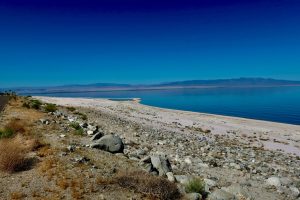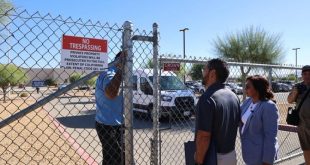 -Editorial
-Editorial
Tom Sephton of Salton Sea Solutions, LLC, presented a comprehensive plan for the restoration and commercial use of Salton Sea water at the Imperial County Board of Supervisors meeting on Nov. 25, outlining a three-phase strategy aimed at improving water quality, restoring habitat, and generating revenue through salt production.
The project builds on Sephton’s decades of experience with energy and water projects, including geothermal plants at the Salton Sea and energy projects across California and the Mohave Desert. Sephton highlighted prior work with Sephton Water Technology, Inc., which developed technologies for desalination, salt recovery, and solar thermal energy generation.
The first phase involves a commercial demonstration plant designed to process hypersaline Salton Sea water, which contains approximately 8.5% salts. The facility would extract and filter the water, recover sodium chloride and gypsum, and return a high percentage of distilled water to the Salton Sea habitat. Purified salt would be sold commercially, with early pilot tests demonstrating feasibility.
According to Sephton, the demonstration plant would use solar thermal heat and energy to separate water from salts. The process would recover approximately 92% of distilled water from the inflow and produce more than 219,000 tons of purified sodium chloride annually, which could be marketed online or through specialty retail. Algal biomass collected during treatment could be processed into compost, and brine byproducts could be used for energy capture.
Financial projections presented indicated that demonstration-scale salt production could generate multimillion-dollar annual revenue while proving the technology at a small scale, creating confidence for private investors and potential large-scale expansion.
Phase 2 expands operations to recycle larger volumes of hypersaline water. The project proposes removing salts from the sea while returning distilled, selenium-free water to aquatic habitats, addressing ecological concerns such as nutrient buildup and declining fish and bird populations. Residual brine would be managed in solar ponds to minimize PM10 dust emissions from exposed lakebeds and capture solar energy for additional processing.
Sephton emphasized that this phase could pay for itself through the commercial sale of purified salt at domestic market prices. Long-term modeling indicated that up to 100,000 acre-feet of water could be treated annually, removing millions of tons of salt and stabilizing water quality over several decades. The plan also anticipates coordination with local water agencies to manage makeup water requirements.
The final phase envisions importing water from the Pacific Ocean or the Sea of Cortez to restore pre-Quantification Settlement Agreement (QSA) water levels in the Salton Sea, fully eliminating exposed playa, reducing dust hazards, and improving overall water quality. Salt and nutrient removal would continue during this phase using desalination and solar evaporation technologies.
Cost estimates for Phase 3 range from $1 billion to $10 billion, depending on the water source and infrastructure route. Modeling presented by Sephton predicts that imported water combined with salt extraction could restore the sea’s elevation within a decade while maintaining marine salinity and supporting ecological recovery over 20 years.
Sephton’s presentation included detailed projections for salt production revenue. Demonstration-scale operations could generate an annual net income of more than $9 million, with potential expansion increasing returns substantially. Marketing strategies would feature premium packaging with an environmental protection story, highlighting the return of clean water to the Salton Sea ecosystem.
Brawley resident Eric Reyes said that as time goes by one issue remains clear: discussions about bringing water from the sea to the Salton Sea have never been taken seriously, even though it is the only viable path to true restoration. He argued that using the word “restoration” without a new water source is misinformation, noting that health and environmental impacts cannot be addressed through mitigation alone.
Reyes pointed out that 250,000 to 300,000 acre-feet of water were lost last year and will continue to be lost, and that ongoing negotiations remain uncertain. He added that a San Diego County Water Authority study found it cheaper to invest billions in new solutions than to rely on Metropolitan Water District wheeling costs. Calling the situation a complex border-wide issue involving multiple regions, Reyes said the concept deserves full support and study. He emphasized that the Imperial Irrigation District receives billions from water transfers yet does not share those funds locally, arguing they should help finance a $5–10 billion project to prevent far greater long-term economic and health impacts.
Supervisor Ryan Kelley said the reason officials continue to use the word “restoration” is because the Salton Sea Restoration Act was developed alongside the QSA, establishing restoration as a promised benefit without creating a financial obligation for the state. He noted that while some call it mitigation or land management, the commitment made was clearly restoration.
Kelley said he recently attended the Salton Sea Authority meeting, where they learned Arizona is actively pursuing a cross-border conveyance while Imperial County has seen decades of discussion with no action. He expressed frustration that the Army Corps’ new evaluation is expected to take eight years, with only a possible preliminary report in four, calling it more of the same endless studies. Kelley said the county is asking for a full explanation of Arizona’s progress and for accountability from Natural Resources, the Salton Sea Authority, and the Bureau of Reclamation, especially since the state is eight years into a ten-year plan and still missing required long-term planning benchmarks. He acknowledged the state’s efforts but stressed they have not met all obligations.
Kelley also highlighted two positive points: that Sephton’s project is creating environmental water that should be considered a commodity for Natural Resources, and jokingly requested that if any Salton Sea salt is sold with a mermaid label, it include a tag stating “Product of the Salton Sea.”


